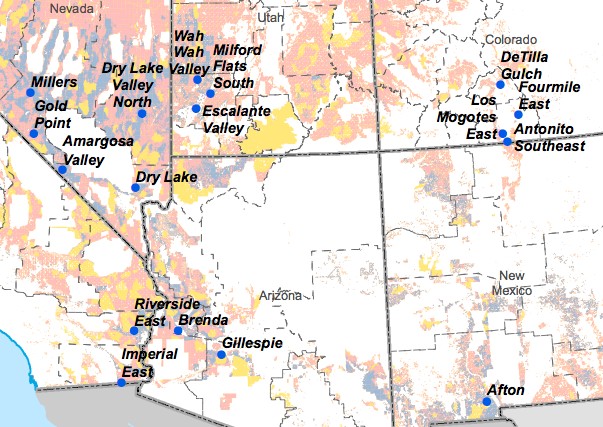In the US, some of the best locations for generating solar power have been off-limits to development because they happen to be on federally owned land. Although the Department of the Interior has approved a number of utility-scale solar projects (17 since 2009), the permitting process remained cumbersome, and there was no way of judging whether these projects represented the best use of federal lands. To help foster the development of solar power, the DOI instituted a full review of both the lands it manages and the permitting process; the results of this review were released earlier this week.
The review focused on land administered by the Bureau of Land Management, and started by excluding about 78 million acres because they had scenic, historic, or cultural value. In the remaining areas, the DOI focused on identifying areas with good solar resources and access to existing or approved transmission infrastructure, so that the power could be easily plugged in to the existing grid. The end result showed 17 Solar Energy Zones (SEZs), covering just under 300,000 acres in Arizona, California, Colorado, Nevada, New Mexico, and Utah. An additional 19 million acres outside these zones were considered appropriate for solar development.
Within the SEZs, developers will be able to use an accelerated permitting process, and will receive economic incentives. In the remaining 19 million acres, obtaining a development permit will now involve a defined process that should make approval less of an ad-hoc process. As part of the program, the BLM will set up a monitoring process that evaluates the initial developments and uses the information to help guide the approval and construction of future ones. That will also be used to develop a mitigation strategy to handle any environmental impacts from the development.
The plan would seem to go a long way toward directing the development of solar power to those areas of the country that have the best resources for actually generating power. So far this year, New Jersey continues to lead the nation in solar installations, although Arizona is now seeing some significant utility-scale installations.
Source: http://arstechnica.com/science/2012/07/us-to-make-solar-energy-development-on-public-land-easier/
 |
| The west's Solar Energy Zones, highlighted in blue. |
The review focused on land administered by the Bureau of Land Management, and started by excluding about 78 million acres because they had scenic, historic, or cultural value. In the remaining areas, the DOI focused on identifying areas with good solar resources and access to existing or approved transmission infrastructure, so that the power could be easily plugged in to the existing grid. The end result showed 17 Solar Energy Zones (SEZs), covering just under 300,000 acres in Arizona, California, Colorado, Nevada, New Mexico, and Utah. An additional 19 million acres outside these zones were considered appropriate for solar development.
Within the SEZs, developers will be able to use an accelerated permitting process, and will receive economic incentives. In the remaining 19 million acres, obtaining a development permit will now involve a defined process that should make approval less of an ad-hoc process. As part of the program, the BLM will set up a monitoring process that evaluates the initial developments and uses the information to help guide the approval and construction of future ones. That will also be used to develop a mitigation strategy to handle any environmental impacts from the development.
The plan would seem to go a long way toward directing the development of solar power to those areas of the country that have the best resources for actually generating power. So far this year, New Jersey continues to lead the nation in solar installations, although Arizona is now seeing some significant utility-scale installations.
Source: http://arstechnica.com/science/2012/07/us-to-make-solar-energy-development-on-public-land-easier/
No comments:
Post a Comment